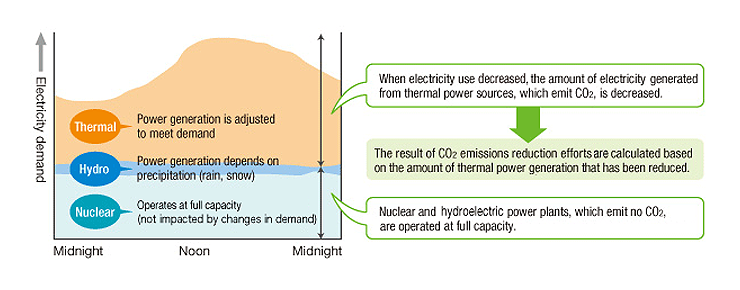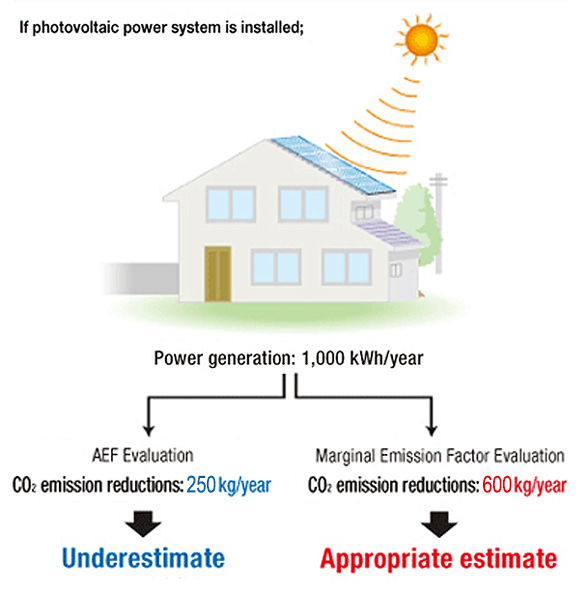Assessment of CO₂ Emissions Reduction Effects
For more information on counter climate change, refer to the Sustainability Report.
Adequate Method to Evaluate Effects of CO2 Emissions Reduction
Reduction in CO2 emissions through reduced electricity use
As CO2 is not emitted where electricity is used, the CO2 emitted at the power plant is considered as being emitted by the customer. This also applies when customers strive to conserve energy, and it is necessary to consider this as the CO2 reductions at the power plant. To do this, it is necessary to identify the power sources whose annual power generated are impacted by demand fluctuations. These are known as marginal power sources. Using the CO2 emission factors of these sources is appropriate to calculate reduced CO2 emission by energy-saving efforts by customers.
Adequate Method to Evaluate Effects of CO2 Emissions Reduction
What is the Marginal Power Source in Japan?
The power sources of Japan include thermal, nuclear and hydro power generation. Nuclear power plants continually generate power except when they are undergoing periodical inspections. Hydropower generation fluctuates annually depending on the amount of rainfall and snowfall. On the other hand, the amount of power generated by thermal power is adjusted to meet demand and so thermal power is considered the marginal power source in Japan.
■ Electricity Production by Type of Power Source (Before the Great East Japan Earthquake)

Formula for calculating CO2 emissions reductions
The following formula is the proper method for calculating CO2 emissions reductions due to reduced electricity consumption using the average CO2emission factor of the thermal power sources as the marginal power source.

- * Source
The emission factors of thermal power sources applied in the Plan for Global Warming Countermeasures adopted at the Cabinet meeting in February 2025.
FY2014: 0.65 kg-CO2 / kWh
FY2031: 0.60 kg-CO2 / kWh
Average Emission Factor (AEF) for all power sources and the Marginal Emission Factor
Generally, CO2 emissions are estimated using the average factor for CO2 emissions for all types of power sources including nuclear, hydro and thermal (Average Emission Factor (AEF)). However, if the AEF is used to estimate CO2 emissions reductions, nuclear and hydro power, which do not change with fluctuations in demand, are considered also to have been reduced. As a result, proper evaluations of CO2 emissions reductions should use the marginal emission factor, which in Japan is the average CO2 emission factor of the thermal power sources.
An example calculated using the emission factors of FY2031 (see above) suggests that it is possible that CO2 emissions reduction evaluations based on AEF will underestimate the effect of introducing solar, wind, biomass, and other alternative energy sources on global warming.
■ Emission Factors Used in the Example Calculation
| Average Emission Factor (AEF) for all power sources | Marginal Emission Factor (emission factor for all thermal power sources) |
|---|---|
| 0.25 kg-CO2/kWh | 0.60 kg-CO2/kWh |
■ Example of Underestimation of CO2 Emissions Reductions when Using AEF

International/domestic standards for CO2 reduction assessment
International standards dictate that CO2 reductions as a result of reduced electricity purchased should be calculated using the marginal emission factor (in Japan, the average emission factor of the thermal power sources). This practice is employed in the Clean Development Mechanism (CDM) process, one of the mechanisms of the United Nation's Kyoto Protocol, as well as international standards such as the Guidelines for Quantifying GHG Reductions from Grid-Connected Electricity Projects, part of the GHG (Greenhouse Gas) Protocol Initiative.
In Japan, the government guidelines for energy conservation include information regarding this method.
Government guidelines employing the Marginal Emission Factor (the average factor of thermal power sources)
The Plan for Global Warming Countermeasures adopted at the Cabinet meeting in February 2025
Average emission factor for all power sources in FY2014: 0.57 kg-CO2/kWh; average emission factor for thermal power sources: 0.65 kg-CO2/kWh
Average emission factor for all power sources in FY2031: 0.25 kg-CO2/kWh; average emission factor for thermal power sources: 0.60 kg-CO2/kWh
[Reference]
“Interim Summary Report by Target Attainment Scenario Subcommittee” compiled by the Global Environmental Committee, Central Environmental Council (2001)
Average emission factor for all power sources: 0.36 kg-CO2/kWh; average emission factor for thermal power sources: 0.69 kg-CO2/kWh
Environmental Reporting Guidelines (FY2013) published by the Ministry of the Environment (April 2012)
Average emission factor for all power sources: 0.36 kg-CO2/kWh; average emission factor for thermal power sources: 0.69 kg-CO2/kWh
- Management Plan
- Management Plan Documents Long-Term Management Vision2030/Medium-Term Management Plan 2026
- Daigas Group's Values
- Daigas Group's Values Daigas Group Corporate Principles Daigas Group Charter of Business Conduct Daigas Group Code of Business Conduct Our Declaration Daigas Group Policies
- Sustainability Management
- Promotion System Materiality of the Daigas Group Stakeholder Engagement History of Co-creation of Value Value Creation Process
- Environment
-
Environment
Environmental Management
Daigas Group Environmental Policy
Estimation Method of Environmental Accounting
Environmental Impact throughout the Daigas Group Value Chain
Environmental Targets
Actions for Climate Change
Assessment of CO₂ Emissions Reduction Effects
Disclosure Based on the TCFD Recommendations:
Recognition of and Action on Risks and Opportunities Contributing to the Resource-Recycling Society Data Trends Regarding Resource Recycling Information Disclosure on the Research Results of Soil and Groundwater Conservation Biodiversity Daigas Group Biodiversity Policy Development of Environmental Technology
- Social
-
Social
Innovation Management
Promoting Business Transformation with DX Research and Development/Intellectual Property/New Businesses Creation Human Resources Management/Human Resources Strategy Targets Human Resources Development DE&I (Diversity, Equity, and Inclusion) Daigas Group Diversity Promotion Policy Work-Life Balance Occupational Health and Safety Communication Between Employees and Company Human Rights
Respect for Human Rights throughout the Value Chain
Human Rights Due Dilligence
Action for Human Rights Daigas Group Human Rights Policy Supply Chain Management Daigas Group Procurement Policy Social Impact of Business Activities in Our Energy Value Chain Customer Health and Safety Customer Satisfaction Community
Co-creation Activities with Local Communities
Activities by Public Interest Incorporated Foundations
- Governance
- Governance Corporate Governance Dialogue between Outside Directors and Institutional Investors Compliance Consultations and Reports from Partner Companies Information Security Protect Personal Information
- Reporting Guidelines
- Global Reporting Initiative (GRI) Index SASB Table Reference for the Environmental Reporting Guidelines of the Ministry of the Environment TCFD Recommendations Table
